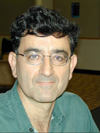Joint Colloquium Distinguished Lecture Series
Computational Challenges in Understanding Gene Regulatory Networks

|
Wednesday, October 1, 2008 306 Soda Hall (HP Auditorium) 4:00 - 5:00 pm Ron Shamir Sackler professor of Bioinformatics School of Computer Science, Tel Aviv University Downloadable PDF |
Abstract:
The genome is the instruction book for generating proteins, the molecular machines that work in our cells. To create each such machine, the gene that encodes it in the genome must be expressed. Over 20,000 genes are available in the human genome, and only a fraction of them are expressed at any given time. The precise regulation of gene expression is key to cell survival and fitness under varying conditions, and mis-regulation is the cause of many human diseases. Hence, understanding how genes are regulated is a central challenge in today's biomedical research.
In this talk I will describe some current computational challenges in understanding gene regulation, and our approaches for handling them. We shall describe methods for discovering regulatory motifs in the DNA sequences co-expressed genes, for revealing transcriptional modules by combined analysis of microarray expression profiles and regulatory sequences, and for tracing the evolution of the regulatory signals.
The talk will be self contained and does not assume prior biological knowledge.
Biography:
Ron Shamir is spending the Fall semester at UC Berkeley on sabbatical from Tel Aviv University. He received a B. Sc. In Mathematics and Physics from the Hebrew University in 1977, and a PhD in Operations Research from UC Berkeley in 1984. He is on the faculty of Tel Aviv University since 1987. He holds the Raymond and Beverly Sackler chair of Bioinformatics at the School of Computer Science, and heads the Edmond J. Safra Bioinformatics Program, Tel Aviv University. He develops novel algorithms to advance biology. His interests include gene expression analysis, comparative genomics, gene regulation, systems biology and disease bioinformatics. He is on the editorial board of eleven scientific journals and series, and has published over 180 scientific papers.
Lecture: streaming vieo
| Return to EECS Joint Colloquium |

